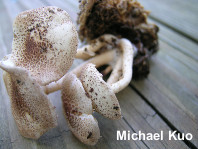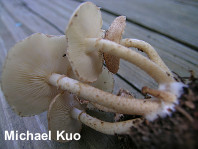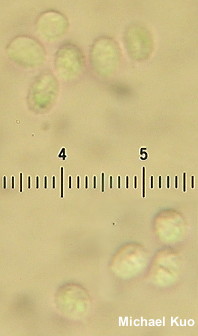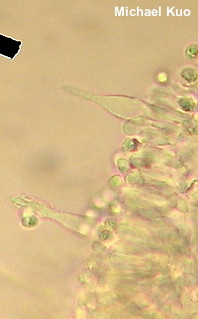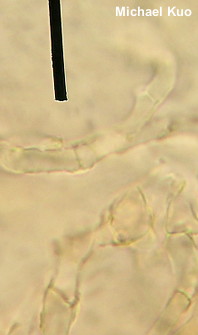| Major Groups > Gilled Mushrooms > Pale-Spored > Ripartitella brasiliensis |

|
Ripartitella brasiliensis [ Basidiomycota > Agaricales > Agaricaceae > Ripartitella . . . ] by Michael Kuo This fascinating mushroom is like a Gulf-Coast cross between Lepiota cristata and a wood-rotting species of Pholiota. It grows from deadwood—especially from oak logs--and is apparently limited to tropical and subtropical regions. In North America it is found along the Gulf Coast, but its range extends into the Caribbean and South America. Identifying features for Ripartitella brasiliensis include its range and ecology; its white spore print; the Lepiota-like appearance; gills that are attached to the stem; and spiny, inamyloid spores. Ripartitella alba, described from Costa Rica, is very similar, but has a paler, less scaly cap, along with more distant gills and smaller spores. Thanks to the Field Museum of Natural History in Chicago for facilitating study of the collection cited below. Description: Ecology: Saprobic on the deadwood of hardwoods, especially oaks; growing densely gregariously or in clusters; causing a white rot; summer, fall, and early winter; along the Gulf Coast. The illustrated and described collections are from Texas. Cap: 1–4 cm; convex at first, becoming broadly convex or nearly flat; dry; smooth and whitish underneath small, brown to reddish brown scales; the margin not lined, but hung with whitish veil fragments. Gills: Narrowly attached to the stem; close; short-gills frequent; white. Stem: 3–5 cm long; 2–5 mm thick; equal; dry; whitish underneath brown to reddish brown scales; with a clearly defined or vague ring zone; often with copious white basal mycelium. Flesh: Whitish; unchanging when sliced. Odor & Taste: Not distinctive. Chemical Reactions: KOH on cap surface negative. Ammonia pale grayish green on brown areas of cap surface. Spore Print: White. Microscopic Features: Spores 4–6 x 3–4 µm; broadly ellipsoid; finely spiny; hyaline in KOH; inamyloid. Pleurocystidia 30–40 x 5–7.5 µm; lageniform, often with a subaciculate apex; hyaline in KOH; walls about 1 µ thick; apices often encrusted with mucilaginous ornamentation that dissolves quickly in KOH. Lamellar trama subparallel. Pileipellis a thin layer of elements 3–6 µm wide, hyaline or slightly brown-encrusted; terminal cells cylindric and slightly inflated, with rounded to subclavate apices; clamp connections present. REFERENCES: (Spegazzini, 1889) Singer, 1951. (Saccardo, 1891; Murrill, 1940 [Marasmius squamosidiscus]; Guzmán Dávalos & Guzmán, 1988; Ovrebo, 1988; Bessette et al., 2007; Capelari & Asai, 2009.) Herb. F C0205423F. This site contains no information about the edibility or toxicity of mushrooms. |
© MushroomExpert.Com |
|
Cite this page as: Kuo, M. (2016, July). Ripartitella brasiliensis. Retrieved from the MushroomExpert.Com Web site: http://www.mushroomexpert.com/ripartitella_brasiliensis.html |
